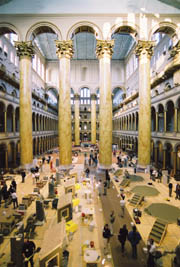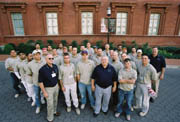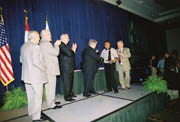
Taking top honors in the plaster contest-and a new Ford F-150 pickup truck-were Patricio Silva, of BAC Local 56 Illinois, followed by Estaban Froylan, of BAC Local 74 Illinois, in second place. Third place winners were Emiliano Froylan and Francisco Mendoza, of BAC Local 74 Illinois, and Kipp Newlun, of BAC Local 9 Wisconsin.
The five plaster finalists had already advanced through a series of regional contests and semifinals held at the IMI National Training Center earlier this year. All contests included hands-on and written tests. Apprentices registered at every level of training were eligible for the contest, which also included brick, tile, stone, marble and cement. Judges at the finals were prominent construction experts in their respective crafts from around the country.

Contest of champions
The International Apprentice Contest "brought some much-deserved recognition to these apprentices, who have already made a significant investment in their careers," says BAC President and IMI Co-Chair John J. Flynn. "Their skills were truly impressive."The challenge in both the semifinal and final plaster competition involved applying veneer plaster with a textural coat on a ceiling, and smooth coat to two walls, plus two EIFS finishes and foam.
For the ceiling, the apprentices had to add sand to veneer plaster to make it textured. Two walls underneath were done with smooth coat veneer plaster.
After that, contestants had to run a chair rail around the smooth coat walls and the inside corner had to be mitered. Next, they stuck rosettes around the wall, "three to a wall," at equal distances.
For EIFS, they had to run two different finishes on the bottom of the smooth coat-1.0 and 1.5 finish-and lay out a wall with EIFS insulation board with backwrap, holding a 3/8-inch caulk joint around window and bottom of wall.
The contest was scheduled for 61⁄2 hours and with the degree of difficulty involved, the contestants used every minute of it.
"Their skill and tool manipulation was really something to be proud of, especially considering the difficulty in their projects," says IMI National Apprenticeship and Training Director Steve Martini.
Those skills did not come by accident. It began formally in 1910, when the international union's name was changed to the Bricklayers, Masons & Plasterers International Union and a definition for plastering was added to the constitution.
Today, many BAC locals offer plaster training programs in a three-year curriculum. IMI complements those programs with additional ones at the National Training Center in Fort Ritchie, Md., and at satellite locations when demand warrants.
The National Training Center offers plaster training in a 12-week pre-job format to help beginners get a faster start, and offers upgrade and cross training to apprentices and journeymen alike. Recent courses include AAC coatings and EIFS coatings.
"There are so many finishes and products out there now," says plaster instructor John Totten. "From ornamental to flat walls, we teach anything that has to do with plaster."
IMI has also had plastering programs in the Job Corps program since 1974.

Everyone's a winner
All BAC/IMI curricula include the OSHA 10-hour course, first aid/CPR, blueprint reading, trade math, and union-related topics such as history, benefits and foreman training.Dedicated, craft-savvy and well-trained instructors are key, notes Steve Nelms, plaster programs coordinator at the BAC Illinois District Council Training Center, which produced four of the five apprentice contest finalists. The DCTC is a 35,000 square-foot facility created when the five Chicago-area locals merged training programs.
He has particular praise for senior instructor Art Johnston, who started a plaster training program at his own Local, BAC 56 Illinois, and was instrumental in setting up the center's program. The plaster apprentice program requires 4,500 hours of work and 480 hours of schooling through the course of a three-year apprenticeship. The curriculum covers conventional plaster, EIFS, cement plaster, decorative interior finishes and ornamental plaster. The center even offers offsite training through its Web site, www.bac2school.org.
The DCTC also collaborates with the Association of the Walls & Ceilings Industries to offer BAC members and contractors the largest EIFS training and certification program to date. It is offered biennially in English and Spanish.
The BAC/IMI training program "played a tremendous part" in the Silva's victory, says his employer Dan Nass, president of Palladio Walls Systems, of Fox River Grove, Ill., whose firm does a lot of high-end work, including stone, stucco and fresco. He also credits Silva's colleagues, and Silva himself, whom Nass noticed early on. "He is personally driven and he expanded his own horizon."
Palladio foreman Sergio Gonzalez agrees: "He is a dedicated person, and he is always trying to be better every time."
Known for his quiet demeanor, Silva nevertheless impressed architects when he participated at IMI Masonry Camp this past June, with his professionalism and skill.
The other contest finalist, Kipp Newlun from Manawa, Wis., learned his top skills by attending a program set up by BAC Locals 3 and 9 in cooperation with the Northeast Wisconsin Technical College in Green Bay, Wis. Newlun works for Cottrell Plastering, of Appleton, Wis., doing largely EIFS work and some conventional plastering.
First place winner Silva barely had time to savor his victory, leaving the next day for a job in New York City for Palladio on a retail storefront. But he made one important stop first-to give the trophy to his instructor and inspiration, Art Johnston.
